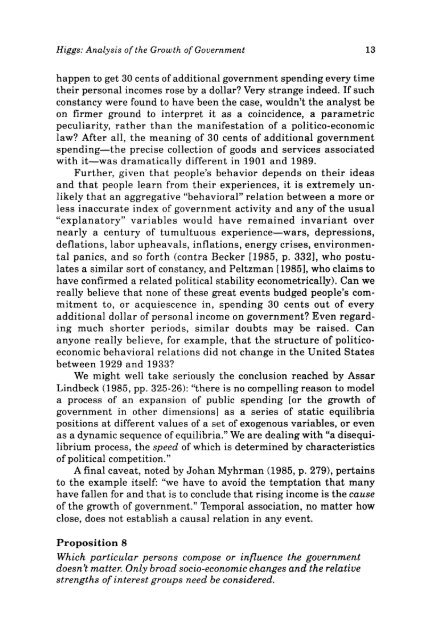Review of Austrian Economics - The Ludwig von Mises Institute
Review of Austrian Economics - The Ludwig von Mises Institute
Review of Austrian Economics - The Ludwig von Mises Institute
Create successful ePaper yourself
Turn your PDF publications into a flip-book with our unique Google optimized e-Paper software.
Higgs: Analysis <strong>of</strong> the Growth <strong>of</strong> Government 13<br />
happen to get 30 cents <strong>of</strong> additional government spending every time<br />
their personal incomes rose by a dollar? Very strange indeed. If such<br />
constancy were found to have been the case, wouldn't the analyst be<br />
on firmer ground to interpret it as a coincidence, a parametric<br />
peculiarity, rather than the manifestation <strong>of</strong> a politico-economic<br />
law? After all, the meaning <strong>of</strong> 30 cents <strong>of</strong> additional government<br />
spending—the precise collection <strong>of</strong> goods and services associated<br />
with it—was dramatically different in 1901 and 1989.<br />
Further, given that people's behavior depends on their ideas<br />
and that people learn from their experiences, it is extremely unlikely<br />
that an aggregative "behavioral" relation between a more or<br />
less inaccurate index <strong>of</strong> government activity and any <strong>of</strong> the usual<br />
"explanatory" variables would have remained invariant over<br />
nearly a century <strong>of</strong> tumultuous experience—wars, depressions,<br />
deflations, labor upheavals, inflations, energy crises, environmental<br />
panics, and so forth (contra Becker [1985, p. 332], who postulates<br />
a similar sort <strong>of</strong> constancy, and Peltzman [1985], who claims to<br />
have confirmed a related political stability econometrically). Can we<br />
really believe that none <strong>of</strong> these great events budged people's commitment<br />
to, or acquiescence in, spending 30 cents out <strong>of</strong> every<br />
additional dollar <strong>of</strong> personal income on government? Even regarding<br />
much shorter periods, similar doubts may be raised. Can<br />
anyone really believe, for example, that the structure <strong>of</strong> politicoeconomic<br />
behavioral relations did not change in the United States<br />
between 1929 and 1933?<br />
We might well take seriously the conclusion reached by Assar<br />
Lindbeck (1985, pp. 325-26): "there is no compelling reason to model<br />
a process <strong>of</strong> an expansion <strong>of</strong> public spending [or the growth <strong>of</strong><br />
government in other dimensions] as a series <strong>of</strong> static equilibria<br />
positions at different values <strong>of</strong> a set <strong>of</strong> exogenous variables, or even<br />
as a dynamic sequence <strong>of</strong> equilibria." We are dealing with "a disequilibrium<br />
process, the speed <strong>of</strong> which is determined by characteristics<br />
<strong>of</strong> political competition."<br />
A final caveat, noted by Johan Myhrman (1985, p. 279), pertains<br />
to the example itself: "we have to avoid the temptation that many<br />
have fallen for and that is to conclude that rising income is the cause<br />
<strong>of</strong> the growth <strong>of</strong> government." Temporal association, no matter how<br />
close, does not establish a causal relation in any event.<br />
Proposition 8<br />
Which particular persons compose or influence the government<br />
doesn't matter. Only broad socio-economic changes and the relative<br />
strengths <strong>of</strong> interest groups need be considered.

















